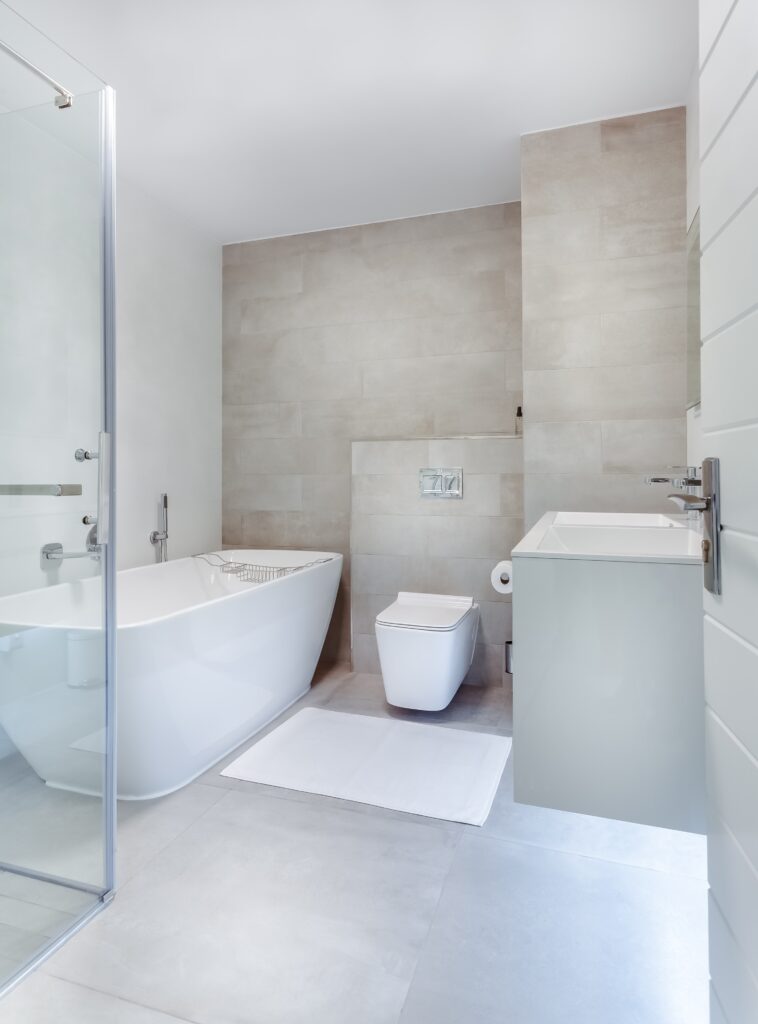The importance of tiles in a home extends beyond aesthetics. As one of the most frequently used and highly visible features in kitchens and bathrooms, tiles play a crucial role in the durability and longevity of these spaces. For the best tips regarding bathroom tiles, reach out to bathroom remodel contractors today.
Types of bathroom tiles
Tiles, unlike other design elements, are exposed to considerable wear and tear due to foot traffic, spills, moisture, heat, and other factors. Therefore, understanding the durability of different types of kitchen and bathroom tiles can be vital in making informed decisions when renovating or designing these spaces.
Ceramic Tiles
Ceramic tiles, composed of clay materials fired at a high temperature, are a popular choice for both kitchen and bathroom environments. Their toughness is attributable to their hardened, robust structure, making them resistant to cracks, chips, and scratches.
Ceramic tiles have a protective glaze that increases their resistance to moisture and stains, making them an excellent choice for bathrooms. However, while ceramic tiles are a sturdy option, their durability can be compromised if the tiles are not correctly installed or if the grout lines are not properly sealed.
Porcelain Tiles
A subtype of ceramic tiles, porcelain tiles, are made using a specific clay type fired at higher temperatures, which results in a denser and less porous tile. This additional density gives porcelain tiles an edge in terms of durability and resistance to moisture and stains.
Porcelain tiles also resist wear and tear better than their non-porcelain counterparts, making them ideal for areas with heavy traffic, such as kitchen floors. On the downside, the hardness of porcelain tiles can make them more challenging to install, which could influence their longevity if not handled correctly.
Glass Tiles
Glass tiles are often used for aesthetic appeal in both kitchens and bathrooms, as they reflect light and add a sense of depth and brightness to a room. Despite their delicate appearance, they are quite durable and resistant to stains, moisture, and mildew. Since they are non-porous, they don’t absorb water, making them an excellent choice for bathrooms. However, they can be prone to scratches and are less tolerant to heavy impact compared to ceramic and porcelain tiles.
Stone Tiles
Natural stone tiles such as granite, marble, slate, and limestone are known for their unique aesthetics, adding a touch of luxury to any kitchen or bathroom. However, their durability varies greatly. Granite, for instance, is extremely hard and durable, highly resistant to scratches, and can withstand high temperatures.
Marble, though beautiful, is more porous and prone to scratches and stains, requiring more maintenance to retain its appeal. Slate is durable and scratch-resistant but can be easily chipped. Limestone is soft and can scratch easily but is relatively resistant to staining. It’s essential to seal stone tiles properly to enhance their durability and resistance to moisture and stains.
Vinyl Tiles
Vinyl tiles are an affordable alternative, known for their comfort underfoot and resilience. They are highly resistant to water damage, stains, and wear and tear, making them an excellent choice for bathroom remodeling Stony Brook. However, they can be prone to dents and scratches from heavy objects, and their lifespan is generally shorter compared to ceramic, porcelain, or stone tiles.
How to maintain different types of tiles?
The first step in maintaining your kitchen and bathroom tiles lies in understanding the type of tile you have. Different materials, such as ceramic, porcelain, glass, stone, and vinyl tiles, each have specific maintenance needs and restrictions. Ceramic and porcelain tiles, for instance, are robust and easy to clean, but abrasive cleaners can dull their surface.
Natural stone tiles, like marble and granite, are porous and require gentle cleaning methods and specific stone-safe products to avoid damage. Understanding your tiles will guide you to the right cleaning products and methods, preventing any unintentional damage while ensuring a deep, thorough clean.
The Importance of Regular Cleaning
Regular cleaning is key in maintaining the aesthetics and durability of your kitchen and bathroom tiles. Dirt and debris can act as abrasives, causing scratches and dulling the tile surface over time. In the kitchen, spills can lead to stains, especially in the grout, while soap scum and hard water deposits can build up in the bathroom.
To combat this, establish a routine of regular sweeping or vacuuming to remove loose dirt and debris. Following this, a gentle mopping or wiping using warm water and a mild detergent can effectively clean the tiles without causing damage. In areas with hard water, using a suitable descaling product can help in removing and preventing lime scale buildup.
The frequency of this deep cleaning will depend on the usage of the area, but as a rule of thumb, it is advisable to perform this thorough cleaning at least once a week for optimal tile maintenance.
Addressing the Grout
Grout is as crucial as the tiles themselves when it comes to maintenance. Due to its porous nature, grout can easily absorb moisture, dirt, and stains, leading to unsightly discoloration and potential mildew growth, particularly in damp environments like bathrooms.
Cleaning the grout requires gentle but effective products to remove dirt without damaging its structure. Specialized grout cleaners or a mild bleach solution can be used for this purpose, but it’s essential to avoid using too much water, which can seep into the grout and cause damage.
Using a small brush, such as an old toothbrush, apply the cleaning solution and scrub gently, then wipe clean with a damp cloth. Remember to rinse thoroughly to remove any residual cleaner, which could attract more dirt if left on the surface.
Sealing Your Tiles and Grout
Tile and grout sealants are vital in maintaining the durability and appearance of your kitchen and bathroom tiles. Ceiling tiles, particularly those made of natural stone, can provide a protective layer, reducing the chance of stains and damage. Similarly, sealing grout helps in preventing moisture absorption, reducing the risk of mold and mildew growth.
It’s recommended to seal tiles and grout shortly after installation and to reapply the sealant periodically, usually every one to two years, depending on the product instructions and usage of the area. The process typically involves applying the sealant, allowing it to penetrate the surface, and then wiping off the excess. Make sure the area is clean and dry before sealing, and always follow the product instructions.
Conclusion
In summary, the durability of kitchen and bathroom tiles can vary significantly, depending on the type of tile chosen. Factors such as the tile’s composition, the manufacturing process, and the maintenance it requires can all influence its durability.
Choosing the right type of tile for your kitchen and bathroom will depend on your aesthetic preferences, budget, and the kind of wear and tear you expect the tiles to endure. Regardless of the choice, proper installation and maintenance by bathroom remodelers East Setauket is important.



